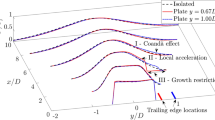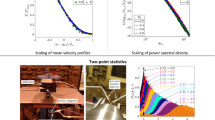Abstract
This work is an experimental study of the turbulent vortex structures and heat transport in the intermediate wake of a slightly heated cylinder. The three components of the vorticity vector were measured simultaneously with the fluctuating temperature at nominally the same point over x/d = 10–40 using a 3D vorticity probe and four cold wires. By using phase-averaging analysis, the contribution of coherent motion of various vorticity correlations such as vorticity-passive heat, as well as the velocity–vorticity correlations has been discussed, in conjunction with Reynolds shear stress and heat fluxes. The results indicate that coherent motion contributes significantly to the heat transport within the vortices while the incoherent motion mainly contributes between two vortices. The vorticity–velocity correlation involving spanwise vorticity component mainly contributes to the gradient of Reynolds shear stress.
Access provided by Autonomous University of Puebla. Download conference paper PDF
Similar content being viewed by others
Keywords
1 Introduction
The flow around a circular cylinder is one of the classical subjects due to its importance in engineering, and it has attracted a great deal of attention in the last few decades. Matsumura and Antonia (1993) presented two-dimensional vorticity field and momentum and heat transport in the intermediate wake of a cylinder. Zhou et al. (2003) obtained three vorticity components using a multi-hot-wire vorticity probe. Zhou et al. (2002b) presented coherent and incoherent momentum and heat fluxes in a turbulent wake of two side-by-side cylinders, using a three-wire probe. One interesting question to be asked is how vorticity components would transport by the fluctuating velocity field? The objective of this work is to investigate the correlations between three components of vorticity and velocity, as well as temperature fluctuations, based on three vorticity components which are simultaneously measured.
2 Experimental Details
The experiments were conducted in a closed-loop wind tunnel with a working section of 1.2 m (W) × 0.8 m (H) and 2 m long at Nanyang Technological University. The free stream across the tunnel is uniform to within 0.5 %. The free stream turbulence intensity is less than 0.5 %. A circular cylinder with a diameter of d = 12.7 mm was used to generate the wake. The free stream velocity U ∞ was 3 m/s, corresponding to a Reynolds number Re \( \left( { \equiv U_{\infty } d/\nu } \right) \) of 2,540. The measurement locations were at x/d = 10, 20, and 40 (where x is the streamwise distance from the cylinder), and only the results of x/d = 10 are presented here. A probe consisting of four X-wires similar in design with that used by Zhou et al. (2002a) was used to measure the three vorticity components simultaneously. Four cold wires were arranged about 1 mm upstream of the four X-wires (or the 3D vorticity probe) to measure the temperature fluctuations at four locations. With these temperature signals, all three temperature gradients involved in the temperature dissipation rate are measured simultaneously with the vorticity signals. Another X-probe located at the edge of the wake was used to provide a phase reference for the measured vorticity signals. The phase-averaged method is similar to that used by Zhou et al. (2002b), and a total of 1,475 periods were used for the phase averaging.
3 Results and Discussion
3.1 Phase-Averaged Vorticity Field
The phase-averaged contours of the three vorticity components \( \left( {\tilde{\omega }_{x}^{*} ,\tilde{\omega }_{y}^{*} {\text{and}} \,\tilde{\omega }_{z}^{*} } \right) \) and temperature \( (\tilde{\theta }^{*} ) \) are similar to that reported by Zhou et al. (2002b, 2003) and not shown here. Here an asterisk denotes normalization by U ∞ , d, and T 0 (where T 0 is the maximum temperature excess). The coherent contribution to three vorticity variances is also calculated (not shown), and the distribution of \( \overline{\overline{{\tilde{\omega }_{z}^{2} }}} /\overline{{\omega_{z}^{2} }} \) shows good agreement with Yiu et al. (2004), where a single overbar denotes time averaging and a double overbar denotes structural averaging.
3.2 Phase-Averaged Reynolds Stress and Heat Fluxes
Figure 1 presents the coherent and incoherent Reynolds shear stress and heat fluxes. The \( \tilde{u}^{*} \tilde{v}^{*} \) (Fig. 1a) positive and negative contours occur in pairs and are similar to that reported by Zhou et al. (2002b). The peak contour value of \( \tilde{u}^{*} \tilde{v}^{*} \) is about an order smaller than that of \( \tilde{v}^{*} \tilde{\theta }^{*} \). The \( \tilde{v}^{*} \tilde{\theta }^{*} \) contours (Fig. 1c) alternate in sign but their size and magnitude are nearly the same, and the extrema of \( \tilde{v}^{*} \tilde{\theta }^{*} \) occurs near the centerline while the extrema of \( \tilde{u}^{*} \tilde{\theta }^{*} \) (Fig. 1b) moves away from the centerline and occurs between the neighboring vortices. There is a close similarity between \( \tilde{v}^{*} \tilde{\theta }^{*} \) (Fig. 1c) and \( \tilde{w}^{*} \tilde{\theta }^{*} \) (Fig. 1d), while the latter one has much smaller values and a change of sign. It also can be seen that the maximum incoherent heat fluxes \( \langle v_{r}^{*} \theta_{r}^{*} \rangle \) (Fig. 1g) is quite comparable to that of the coherent counterpart \( \tilde{v}^{*} \tilde{\theta }^{*} \) (Fig. 1c), which means both coherent and incoherent motion contribute to the heat transport. However, the extrema of \( \langle v_{r}^{*} \theta_{r}^{*} \rangle \) shifts outside the vortices and occurs in the alleyway between two vortices. It seems that the net heat transport within the vortex is due to the coherent motion, while the incoherent motion contributes to heat transport between two vortices.
Phase-averaged coherent shear stress \( \tilde{u}^{*} \tilde{v}^{*} \) (a), and heat fluxes \( \left( {\tilde{u}^{*} \tilde{\theta }^{*} ,\tilde{v}^{*} \tilde{\theta }^{*} ,\tilde{w}^{*} \tilde{\theta }^{*} } \right) \) (b–d); incoherent shear stress \( \langle u_{r}^{*} v_{r}^{*} \rangle \) (e), and incoherent heat fluxes \( \left( { \langle u_{r}^{*} \theta_{r}^{*} \rangle , \langle v_{r}^{*} \theta_{r}^{*} \rangle , \langle w_{r}^{*} \theta_{r}^{*} \rangle } \right) \) (f–h). Contour interval = 0.005 for (a), (b) and (d); contour interval = 0.02 for (c); contour interval = 0.005 for (e); contour interval = 0.01 for (f)–(h). The thicker solid line denotes the outmost vorticity \( \tilde{\omega }_{z}^{*} \) contour
3.3 Phase-Averaged Correlation Between Vorticity and Passive Heat
The phase-averaged isocorrelation of vorticity and temperature fluctuations are shown in Fig. 2. It can be seen that \( \tilde{\omega }_{z}^{*} \tilde{\theta }^{*} \) (Fig. 2c) is considerably greater in magnitude than that of \( \tilde{\omega }_{x}^{*} \tilde{\theta }^{*} \) and \( \tilde{\omega }_{y}^{*} \tilde{\theta }^{*} \) (Fig. 2a, b). There is a close similarity between spanwise vorticity (contours are not shown here) and \( \tilde{\omega }_{z}^{*} \tilde{\theta }^{*} \), which would imply that the spanwise structures have a strong connection with passive heat and tend to retain heat. However, the longitudinal structures have very weak correlation with temperature fluctuations. Note that all of the incoherent correlations are significantly larger than those coherent counterparts. Further analysis on the correlation between vorticity and temperature dissipation rate will be examined.
Phase averaged coherent \( \left( {\tilde{\omega }_{x}^{*} \tilde{\theta }^{*} ,\tilde{\omega }_{y}^{*} \tilde{\theta }^{*} ,\tilde{\omega }_{z}^{*} \tilde{\theta }^{*} } \right) \) (a–c) and incoherent vorticity-heat correlation \( \left( { \langle \omega_{xr}^{*} \theta_{r}^{*} \rangle , \langle \omega_{yr}^{*} \theta_{r}^{*} \rangle , \langle \omega_{zr}^{*} \theta_{r}^{*} \rangle } \right) \) (d–f). Contour interval = 0.02 for (a), (b), (d) and (e); contour interval = 0.1 for (c) and (f). The thicker solid line denotes the outmost vorticity \( \tilde{\omega }_{z}^{*} \) contour
3.4 Time-Averaging and Phase-Averaged Vorticity–Velocity Correlations
The time-averaging profile of vorticity–velocity correlations \( \left( {\overline{{\omega_{z}^{\prime} v^{\prime} }} ,\overline{{\omega_{y}^{\prime} w^{\prime} }} } \right) \) are not shown here. As y/d increases, \( |\overline{{\omega_{z}^{\prime} v^{\prime} }} | \) decrease significantly, and the trough value occurs at y/d = 0, while \( |\overline{{\omega_{y}^{\prime} w^{\prime} }} | \) behaves quite evenly. The phase-averaged contours are shown in Fig. 3. The \( \widetilde{|\omega }_{y}^{*} \widetilde{w}^{*} | \) is about two orders of magnitude smaller than \( |\widetilde{\omega }_{z}^{*} \widetilde{v}^{*} | \), which indicate that the contribution to the gradient of Reynolds shear stress are dominated by the correlation involving the spanwise vorticity component. Other velocity–vorticity correlations such as \( \overline{{\omega_{z}^{\prime} u^{\prime} }} ,\overline{{\omega_{x}^{\prime} w^{\prime} }} ,\overline{{\omega_{y}^{\prime} u^{\prime} }} \) and \( \overline{{\omega_{x}^{\prime} v^{\prime} }} \) will be further discussed in the future.
4 Conclusions
The three components of vorticity were measured simultaneously with the temperature fluctuations in a slightly heated cylinder wake and analyzed using the phase-averaging technique. It has been found that the coherent motion contributes significantly to the heat transport within the vortices while the incoherent motion mainly contributes heat transport between two vortices. The correlation of vorticity–velocity involving spanwise vorticity component mainly contributes to the gradient of Reynolds shear stress.
References
Matsumura M, Antonia RA (1993) Momentum and heat transport in the turbulent intermediate wake of a circular cylinder. J Fluid Mech 250:651–668
Yiu MW, Zhou Y, Zhou T, Cheng L (2004) Reynolds number effects on three-dimensional vorticity in a turbulent wake. AIAA 42(5):1009–1016
Zhou T, Antonia RA, Chua LP (2002a) Performance of a probe for measuring turbulent energy and temperature dissipation rates. Exp Fluids 33:334–345
Zhou Y, Zhang HJ, Yiu MW (2002b) The turbulent wake of two side-by-side circular cylinders. J Fluid Mech 458:303–332
Zhou T, Zhou Y, Yiu MW et al (2003) Three dimensional vorticity in a turbulent cylinder. Exp Fluids 35:459–471
Acknowledgments
The support from the Natural Science Foundation of China (11172085) is gratefully acknowledged.
Author information
Authors and Affiliations
Corresponding author
Editor information
Editors and Affiliations
Rights and permissions
Copyright information
© 2014 Springer-Verlag Berlin Heidelberg
About this paper
Cite this paper
Cao, H., Zhou, T., Zhou, Y., Zhang, H. (2014). Simultaneously Measured Vorticity and Passive Heat in a Cylinder Wake. In: Zhou, Y., Liu, Y., Huang, L., Hodges, D. (eds) Fluid-Structure-Sound Interactions and Control. Lecture Notes in Mechanical Engineering. Springer, Berlin, Heidelberg. https://doi.org/10.1007/978-3-642-40371-2_28
Download citation
DOI: https://doi.org/10.1007/978-3-642-40371-2_28
Published:
Publisher Name: Springer, Berlin, Heidelberg
Print ISBN: 978-3-642-40370-5
Online ISBN: 978-3-642-40371-2
eBook Packages: EngineeringEngineering (R0)







